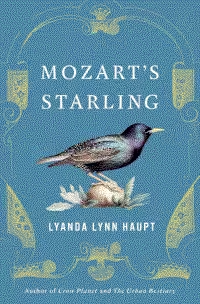Book review: Mozart’s Starling

| Title: | Mozart’s Starling |
|---|---|
| Author: | Lyanda Lynn Haupt |
| ISBN: | 9780316269568 |
| Year published: | 2017 |
| Year I read: | 2025 |
| Rating: | ★★★★✫ I was entertained |
| Recommended for: | People willing to give starlings a chance |
European starlings are reviled in the United States, where they are an invasive species. They are called pests and trash birds, are known to be aggressive towards native species, and commit a great amount of crop damage.
But starlings themselves are actually quite attractive birds, with iridescent feathers, star-like speckles, and a talent for mimicry that led the great Mozart to keep one as a pet.
If this juxtaposition appeals to you, and you don’t hate starlings with murderous intensity, then you may enjoy Mozart’s Starling!
Overall, I was entertained by Haupt’s writing, especially given as I was already fascinated by the premise before I cracked open the book.
Her vignettes and stories of her pet starling, Carmen, were very entertaining to me. Having a pet starling sounds outlandish and impractical, but hey, if somebody has the means to give that bird a loving home, it makes for interesting reading.
In fact, her stories of Carmen were so charming and vivid, that sometimes the transition back to talking about Mozart felt a little forced. For example, there were many lovely, long passages about Carmen, and after several paragraphs, they would end with “...and Mozart must have lived like this too.”
I mean, maybe. Historically, we know very little about Mozart’s starling – the namesake of the book – so the rest is left to conjecture and imagination.
Unless the book were about 50 pages shorter, this is to be expected, and wasn’t overly bothersome. It kind of overstayed its welcome once Haupt started to argue about how Mozart was probably used to starling poop smearing his manuscripts while he was working, connecting it to his weird letters about poop and her experience with her starling pooping all over stuff.
To be honest, there’s quite a bit of poop in this book. Maybe I just don’t like reading about poop.
Maybe this book would have benefited from just being an appreciation of starlings in general, rather than revolving around Mozart’s starling, but I understand that was really Haupt’s vision, given that she pilgrimaged all the way to Salzburg and Vienna for Mozart’s sake.
As I got further in, I embraced the way it randomly flits from topic to topic. Like Mozart’s letters and whimsical operas, this is not a book to be taken too seriously. It’s entertainment to be enjoyed, with a few interesting musings on ecology, human-animal relationships, and music here and there.
Quotes
Starlings thrive in areas that are disturbed by human presence, including dense urban environments – places that more sensitive species simply cannot survive in the long term. For now, it seems some birds go elsewhere when their nests are usurped by starlings. But as human sprawl continues, good habitat areas are getting smaller and smaller and may someday disappear altogeteher. What happens when there is no elsewhere? Do we shrug our shoulders and accept that we have created a world in which only starlings and a few other robust species can manage to thrive?
[...] our task is not simply to get rid of starlings. We need to design human landscapes that are hospitable to more species of native birds. This means less grass and more trees. We need to lobby for the creation and protection of woodland parks and forests on large and small scales.